ANCIENT GREEK CLASSICAL AGE (500 B.C. TO 323 B.C.)
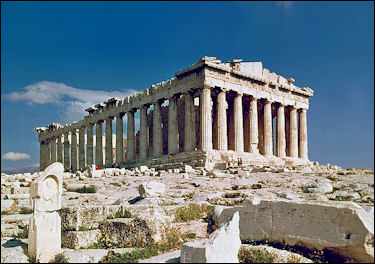
Parthenon in AthensThe Greek Classical Age began with Greece's wars with Persia and ended with Alexander's march of conquest through the Middle East and Asia.
Politically Greece was never unified like the Roman empire. What bound the Greeks together was culture, architecture, sculpture, drama and music. Rugged mountain ranges and numerous bodies of water divided the civilization into individual city-states that existed in valleys and on islands and peninsulas. Roads and waterways made the sharing of culture possible, but the natural barriers made each city-state autonomous politically and agriculturally. [Source: "The Creators" by Daniel Boorstin,"]
When the Greeks emerged as a significant civilization, the Persians were far and away the most dominant culture and military power in the Middle East and the eastern Mediterranean. The Greeks were still unified city-states. What united the Greeks militarily was their willingness to fight together against the Persians.
Ancient Greek City States
Ancient Greece was divided in polises , or city-states, which were neither cities or states. They were self sufficient communities with their own army, customs and laws. Each polis contained one town, which was also the center of the government. The first true city states have been traced to Dorian settlements (850-750 B.C.) on Crete, where constitutions were drawn up that granted certain rights to the Dorian conquerors but denied them to everybody else. Between 750 and 500 B.C. chiefdoms and villages coalesced into city-states on the Greek mainland, Aegean islands and Asia.

Cavalcade frieze on the ParthenonMany city-states were centered around citadels built on mounds or hills (an acropolis) hills for protection. Within the settlement were houses, an agora , or marketplace, and temples for worshiping. Their authority often spread no further that the surrounding plains or valley. The historian Daniel Boorstin wrote, they were "just large enough and just small enough, neither wholly urban nor wholly rural, for it needed both countryside and city...The polis strictly speaking consisted not of the territory but of the citizens...there were several hundred such Greek polis so varied that general history of them is not possible."
The polis had a “religion-like importance." Different city-states had different forms of government. Many began as oligarchies ruled by land-owning aristocrats. Most had councils made up of male citizens that made laws. Some suggest that temples with large central room may have been used for political as well as religious assemblies. As thedemos , or people, gained more say, democracies arose, most famously in Athens.
Powerful Greek City States
Among the most pwerful city states were Athens, Corinth, Thebes, Greek islands such as Lesbos, Chios, Rhodes, Asia Minor City States.
Messenia was a city state in the western Peloponnesus area if Greece. The region is surprisingly lush, with valleys and hills filled with olive groves, fig trees and melon patches. The historical ruins includes Mycenaean tombs. The ruins of ancient Messenia (near Kalamata in the southwestern Peloponnese) are considered one of the best examples of military architecture in ancient Greece. Parts of the former 6 mile-long circular wall are still intact along with several gates which have reinforced two-story towers. Large stone slabs that lead into the main gate still bear the marks of chariot wheels. It is possible to climb around in the defensive wall's 30 square of semicircular watchtowers and walk through the Arcadian gate in the interior courtyard. At the center of the ancient city is Asclepeion (shrine to healing god Ascelpius) with its 235-by-219-feet central courtyard.
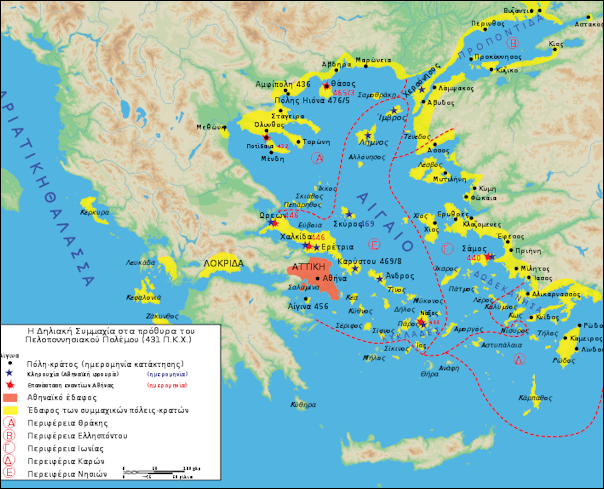
Athenian empire in 431 BC
Ancient Athens
Ancient Athens was claimed according to legend by the goddess Athena after she defeated the sing king Poseidon in an epic battle. The first settlement of Athens, dated to around 3000 B.C. was situated on the rock of Acropolis. By 1400 BC the settlement had become an important center of the Mycenaean civilization and the Acropolis was the site of a major Mycenaean fortress whose remains can be recognised from sections of the characteristic Cyclopean walls. Unlike other Mycenaean centers, such as Mycenae and Pylos, we do not know whether Athens suffered destruction in about 1200 BC, an event often attributed to a Dorian invasion, and the Athenians always maintained that they were "pure" Ionians with no Dorian element. However, Athens, like many other Bronze Age settlements, went into economic decline for around 150 years following this.
Iron Age burials, in the Kerameikos and other locations, are often richly provided for and demonstrate that from 900 BC onwards Athens was one of the leading centres of trade and prosperity in the region. This position may well have resulted from its central location in the Greek world, its secure stronghold on the Acropolis and its access to the sea, which gave it a natural advantage over inland rivals such as Thebes and Sparta.
According to the tradition, Athens was founded, when the king Theseus united in a state several settlements of Attica and ruled by kings until the 9th century B.C. From later accounts, it is believed that these kings stood at the head of a land-owning aristocracy known as the Eupatridae (the 'well-born'), whose instrument of government was a Council which met on the Hill of Ares, called the Areopagus and appointed the chief city officials, the archons and the polemarch (commander-in-chief).
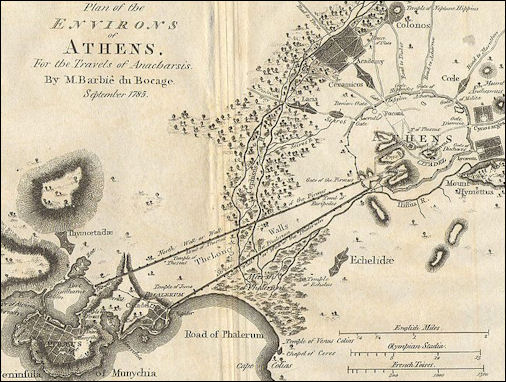
Map of Athens
Before the concept of the political state arose, four tribes based upon family relationships dominated the area. The members had certain rights, privileges, and obligations including common religious rights, a common burial place and mutual rights of succession to property of deceased members. During this period, Athens succeeded in bringing the other towns of Attica under its rule. This process of synoikismos---the bringing together into one home---created the largest and wealthiest state on the Greek mainland, but it also created a larger class of people excluded from political life by the nobility. By the 7th century BC social unrest had become widespread, and the Areopagus appointed Draco to draft a strict new code of law (hence the word 'draconian'). When this failed, they appointed Solon, with a mandate to create a new constitution (in 594 BC). [Source: Wikipedia]
Unlike Sparta, which rose through its military might, Athens became a large power by way of trade and naval supremacy, a course it took namely because it was surrounded by poor soils and it needed to feed its population somehow.
In the golden age of Athens and the Greece in the 5th century B.C. Athens was the heart of the classical Greek civilization and a pioneer of democracy. In 3rd and 4th centuries B.C. Socrates, Plato and Aristotle addressed their followers in markets ans academies and tragedies by Sophocles and Aristhosenes were performed in the amphitheaters. The acropolis was the center of the ancient city. Other classical building are buried beneath the modern city where they are occasionally unearthed by sewer and subway construction workers.

Spartan swordman Ancient Athens spread out around the Acropolis. It was a walled city whose main gates---the Dipylon Gate, Sacred Gate and Petriac Gate---were on the northwest side of the city. Other main important places were the Lyceum (outside the walls), the Olympieion, the Pynx, the Aereopagus and the Agora, the main shopping area and gathering place. The ruins of the Lyceum, where Aristotle taught 2,300 years ago, was uncovered in the mid 1990s in downtown Athens.
Sparta
Sparta was one of the greatest city-states of ancient Greece and for a long time the main rival of Athens. Unlike Athens which became a large power by way of trade and naval supremacy, Sparta rose through its military might and bravery. It was said that while Athens was centered around great buildings, Sparta was built by courageous men who “served their city in the place of walls of bricks."
The Spartan army was small. It was the only professional force in Greece. In Sparta every grown male was a soldier granted a farm run by slaves. The Spartans army was trained to fight in a phalanx, using a tight gird of overlapping shields to form an impenetrable mobile unit.
Sparta began as a small city state with five villages. It later grew into a larger one by first gobbling up surrounding villages and then conquering neighboring large states and eventually claiming nearly all the Peloponnese, and enslaving many of the people that lived there to acquire land. By 650 B.C., Sparta was one of the most powerful city-state in Greece. Admired and feared, it was ruled by a warrior caste and employed a full-time army that was created to quell revolts but was later was used in military campaigns of conquest.
 Sparta subjugated an area of the western Peloponnese and forced its people to become Sparta's helots , or serfs. By some estimates the helots outnumbered Spartans by 10 to 1. The Messenians, who greatly outnumbered Spartans, once revolted only to be brutally put down by the Spartans. After that the Spartans vowed to never let a similar situation occur again and established a totalitarian state.
Sparta subjugated an area of the western Peloponnese and forced its people to become Sparta's helots , or serfs. By some estimates the helots outnumbered Spartans by 10 to 1. The Messenians, who greatly outnumbered Spartans, once revolted only to be brutally put down by the Spartans. After that the Spartans vowed to never let a similar situation occur again and established a totalitarian state.
Sparta controlled more territory than any other city-state. It became so powerful that the only way it could be controlled was through alliances formed by the major Greek powers---Argos, Athens, Corinth and Thebes. Sparta eventually crumbled in 362 B.C., when its army was defeated by the Thebians at the great Battle of Mantinea.
Today, the ruins of ancient Sparta (behind a soccer stadium a couple of miles southeast of the modern city of Sparta) consists of temple fragments, toppled columns, a small hill where the acropolis once stood, a theater built into a hillside during Hellenistic times and a modern statue of Leonidas, the Spartan general who died along with all but two of his men to save Greece from Persia. There is also the ruins a shrine built by the Spartans to honor Helen, where pregnant women went to pray for their children not to be deformed. Herodotus described how Athena once appeared at the temple and told an ugly girl that she would become a beautiful woman. For the most part ruins are unremarkable.
Book: The Spartans: The World of the Warrior-Heroes of Ancient Greece by Paul Cartledge, a professor at Cambridge University
Ancient Corinth
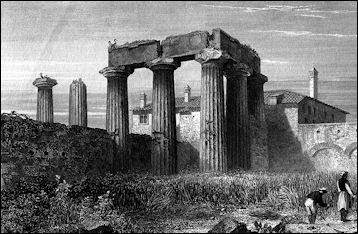
Corinth Apollo templeAncient Corinth (3 miles south of modern Corinth) spreads out at the foot of a huge 1700 foot rock called the Acrocorinth (acropolis). The long walls that surround the city descend all the way from the Acrocorinth to an artificial harbor on the Corinthian Gulf. Cornith was one of the greatest and most enduring Greek city states. It rivaled Athens and Sparta, colonized Sicily and Corfu, and survived well into the Roman age when it was a famous shipbuilding center.
When St. Paul visited he said, "It is reported commonly that there is fornication among you" (I Corinthians 5:1). Berma is believed to the the spot where he was acquitted on charges of preaching Christianity by the local Jewish population (th incident more likely took place in one of Corinth's basilicas.
The Doric temple of Apollo (540 B.C.), the most important temple in the city, stands on a small knoll. Nearby is a theater (4th century B.C.) modified by the Romans, and the well preserved Fountain of Peirene, a rectangular pool with painted fish, six arches and six basins that still spit out water brought through tunnels from a spring two miles away. Ancient Corinth also contains the remains on a 700-foot-long agora (marketplace) with a rostra (stone podium for speeches) and small Roman buildings including shops, civic buildings and a bouleterion (local senate).
On top of the Acrocorinth there used to a Greco-Roman fort but in the 13th century it was replaced by a huge Franco-Byzantine fortress (the largest and oldest in the Peloponnese). The museum in ancient Corinth contains mosaic floors, terra cotta sphinxes, statues of supernatural beings, Roman statues, 5000-year-old pottery,
Nemea (near Corinth) has a stadium where Olympic-style events were held in ancient times. A stunning 120-foot vaulted stone tunnel leads to the stadium and to a building with columns, and perhaps a locker room. Nemea stadium, the site of a sports festival similar to the Olympics, is horseshoe-shaped and contains oldest known locker room. Ancient graffiti "Akrotatos Is Beautiful" a reference to a Spartan prince. Nearby Sicycon also has a stadium, several theaters and a Roman bath that has been converted into a museum.
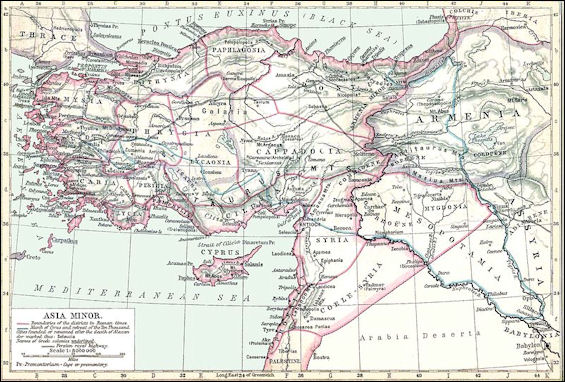
Asia Minor
Greece and Asia Minor
Although Asia Minor (Turkey) was not the center of Greek culture, many of the great cities we associate with ancient Greece (Troy, Ephesus and Aphrodisias to name a few) were actually in present-day western Turkey. Two of the seven wonders of the world (the Mausoleum of Halicarnassus and the Temple of Diana) were also there and a third (the Colossus of Rhodes) was only a few miles away.
Greek philosophy also began in Asia Minor with Thales (634-546B.C.), who was the first man recorded to have speculated about nature of matter and the universe. Pythagoras (580-500 B.C.), the father of mathematics also spent time on Asia Minor. Plato (428-347 B.C.)and Socrates (470-399 B.C.) are known as the founders of idealism and Aristotle (384-322 B.C.) was the first man to classify and unite fields of study into a system."↕
Ionic and Doric are two more terms you are probably familiar with, especially in reference to columns, but again you may not be exactly sure of their meaning. Ionic refers to the culture and architecture that originated in Asia Minor and Doric refers to the culture that began in Greece itself. The fact that Ionian architecture became the main architectural form of antiquity is a further illustration of just how important present-day Turkey was in ancient times. The Ionians had a reputation for being luxury loving while the Spartans were known for being dour and ultraconservative.

Pergamonmuseum altar
Pergamum
Pergamum (about 60 miles north of Izmir) is one of the most beautifully situated set of Greek ruins in Turkey, or for that matter Greece. Located on the top of a small mountain with views in every direction, the ruins spread out over a large area and include the temples of Troy and Dionysus, the sanctuary of Demeter, the celebrated library, and a three-tiered gymnasium. Built into the side of the mountain is an impressive amphitheater with 15,000 seats.
Pergamum (Bergama) was a powerful Hellenistic colony that ruled over a large amount of land in Asia Minor in third and second centuries B.C. At it is height more than 200,000 people lived on the mountain and the surrounding plains. The library's collection of scrolls was so impressive the Egyptians slapped a papyrus embargo on Pergamum out of fear their collection of scrolls would surpass the collection in Alexandria. In response to this Pergamum scribes made "paper" from animal skins. The English word "parchment" is derived from "Pergamene paper." In the end Marc Anthony gave the city and library to Cleopatra who had many the scrolls transported to Alexandria.
The book of Revelations in the Bible referred to ancient Pergamum as a place "where Satan dwelleth." But despite this, and the fact that Roman priests used to martyr Christians here, Pergamum was the site of one the original "Seven Churches." Much of Pergamum was destoryed in a wave of earthquake's between the mid-forth and mid-sixth century that also brough down mch or Troy, Aphrodisias, Ephesus and Smyrna.
Pergamum was discovered in the late 19th century by German engineer Carl Humann. With the help 2,000 workmen, 1,000 oxen and 500 camels, he excavated the famous Altar of Zeus from inside a wall of a Byzantine building. In all he uncovered 97 marble slabs and 2000 fragments from the main frieze, 36 slabs and 100 fragments of a smaller frieze and numerous statues and architectural pieces---all as good a quality as the Elgin marbles.
These items were packed in 462 cases and shipped off to Berlin. At first the Ottoman government wanted two thirds of the finds but eventually they signed a contract to sell them for 20,000 marks. Today the entire altar sits reassembled inside a huge room in Berlin's Pergamum museum. When I was in Pergamum the Turks had pinned up banners all over town claiming they wanted the alter back the same the Greeks want the Elgin Marbles back. [Information for this section was taken from an article on Pergamum by Stanley Meisler, Smithsonian magazine, October 1991].
Other Greek City States in Asia Minor
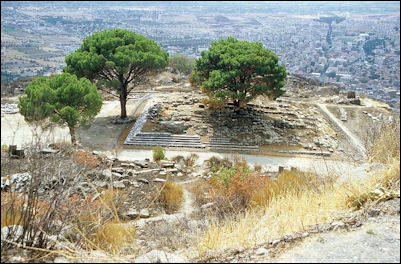
PergamonDidya's Sanctuary of Apollo is the third largest Greek temple in the world. Surrounded by a portico with double colonnades and impressive columns, this temple was as famous as the one in Delphi for its oracles. Didya was eclipsed by Delphi however when a Lycian king asked both oracles a question about what he was doing on a particular day. Only the seeress of Delphi got the right answer---the king was boiling a tortoise and a lamb in a bronze caldron. Milet has a well preserved Faustian bath and a 25,000 seat amphitheater not far from the sea. Priene was one the world's first cities to be laid out in a grid. This 2500-year-old site features a temple of Athena, an amphitheater, stadium and gymnasium.
Perge (15 miles east of Antalya) is one of the best preserved ancient Greek sites in Turkey. It embraces a protective wall, triumphant gateway, colorful mosaic sidewalks, and a marketplace with a great colonnade. The hippodrome still has most of its arches, the marble streets are still lined with columns from the promenades, and the theater has not been looted of all its marble reliefs.
Aspendos (30 miles east of Antalya) is another Greek site. Even more impressive than Perge, it includes a large market place, a large theater, a racetrack larger than a NFL stadium, aqueduct brought water 20 miles from the Tarsus Mountains. The magnificent 15,000 seat theater is in better condition than many of the new movie theaters in Istanbul. During the summer the ancient theater hosts classical music concerts.
Greek Colonies
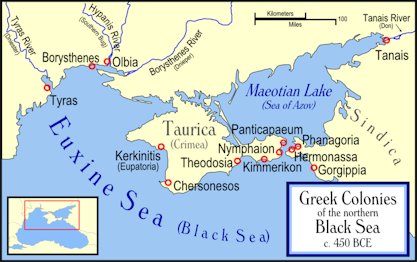
Greek Colonies of the north Black SeaThe Greeks traded all over the Mediterranean with metal coinage (introduced by the Lydians in Asia Minor before 700 B.C.); colonies were founded around the Mediterranean and Black Sea shores (Cumae in Italy 760 B.C., Massalia in France 600 B.C.) Metropleis (mother cities) founded colonies abroad to provide food and resources for their rising populations. In this way Greek culture was spread to a fairly wide area. ↕
Beginning in the 8th century B.C., the Greeks set up colonies in Sicily and southern Italy that endured for 500 years, and, many historians argue, provided the spark that ignited Greek golden age. The most intensive colonization took place in Italy although outposts were set up as far west as France and Spain and as far east as the Black Sea, where the established cities as Socrates noted like "frogs around a pond." On the European mainland, Greek warriors encountered the Gauls who the Greeks said "knew how to die, barbarians though they were." [Source: Rick Gore, National Geographic, November 1994]
During this period in history the Mediterranean Sea was frontier as challenging to the Greeks as the Atlantic was to 15th century European explorers like Columbus. Why did the Greeks head west? "They were driven in part by curiosity," a British historian told National Geographic. "Real curiosity. They wanted to know what lay on the other side of the sea." They also expanded abroad to get rich and ease tensions at home where rival city-states fought with one another over land and resources. Some Greeks became quite wealthy trading things like Etruscan metals and Black Sea grain.
Greek Colonies in Italy
The Greeks city states set up a number of colonies in Italy, known then as Magan Graecia (Great Greece), on the site of established town. The first known Greek settlement was established on Pithekoussai, an island off of present-day Naples, in 770 B.C. A few years later colonies were established in Sicily and southern Italy. Many of the early settlers were poor farmers looking for a better life the same way immigrants from Europe came to America in the 19th century to seek their fortune.
The two greatest Greek colonies in Italy were probably Syracuse and Sybaris. "Magna Graecia and Sicily became the Texas of the Greek world," one historian wrote. "Everything was bigger, bolder. It was a grand experiment." Sicily was known as "Sicily the rich" and "the pride of the blossoming earth." In 443 B.C., Pericles---the great leader of Athens--- founded the colony of Thurii on the instep of Italy's boot following advise from the oracle of Delphi. For political reasons he asked other city states to join him and called it a Panhellenic colony.
Two important concepts in the development of mankind---democracy and the construction of cities in a grid pattern---are believed to have evolved in the Greek colonies in Italy. Archimedes and Pythagoras came from Italy and many of the great Greek philosophers that preceded Socrates, were also from the west. The Sicilian city state of Syracuse crushed an invasion from Athens in 413 B.C.
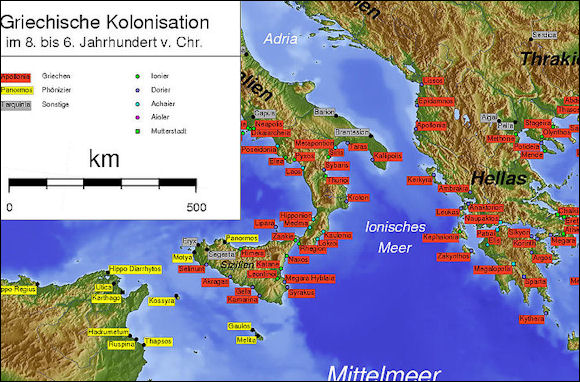
Greek colonization of Sicily
Paestum---south of Salerno in southern Italy---is one of the most impressive set of Greek ruins in the world. The "Temple of Poseidon" looks like a smaller version of the Parthenon (built around the same time) in Athens on steroids. Built about 100 years before is the equally impressive "Basilica." It lacks a roof but it has massive columns that bulge at the bottom. It is long and looks more "elastic." Other ruins include the Temple of Cerese (a 2500-year-old temple later turned into a church), the Roman forum, the gymnasium, the Roman amphitheater, the 2,600-year-old basilica, a museum with paintings and pottery taken from Paestum tombs. Make sure to check out the famous Tomb of the Diver. There is a private beach about a mile and a half from the Paestum.
On Sicily the Greeks established numerous colonies and left behind monumental temples and theaters which draw large numbers of tourists today. Eastern Sicily is said to have been the inspiration for the myth of Persephone and the seasons. Morgantina (near Armerina) is a Greek city on Sicily that was colonized in the 6th century B.C. and sacked by the Romans in the 3rd century B.C. has produced some of the most spectacular archaeological and looted discoveries made in recant years. Before the Roman invaded, the Greeks buried their wealth. Other Ancient Sites include the Greek ruins of Gela, Agrigento and Selinunte.
Syracuse (in the southeastern corner of Sicily) was almost as powerful as Athens during the golden age of Greece. During Hellenistic times, Syracuse along with Athens and Alexandria were the greatest centers of Greek culture. The city is closely associated with Archimedes. Syracuse's harbor was one of the best in the Mediterranean. An attack by the Sicilian city state against Athens led to the fall of the ancient Greece's most famous city. Although Syracuse invasion was unsuccessful it crushed Athens' sea defenses, allowing the Spartan's to sack Athens a few years later.
Delian League and the Payment of Tribute Money to Athens

Olympia ZeusTempleConcerned about further attacks by Persia, 200 Greek city-states formed an Athens-led alliance called the Delian League (sometimes also called the Delios League) in 478 B.C. In exchange for money or ships, Athens fleet of ships evicted the Persians, cleared out pirates and secured trade access to the Black Sea. As Athens’ power grew other city states resented their position as "subjects."
Named after the site of it headquarters, the sacred island of Delos, the Delian League was essentially a organization set up for city states to pay tribute money to Athens in exchange for protection. The arrangement wasn't all that different from protection money paid by businesses to organized gangs.
With this money Athens beefed up its navy, making it even stronger, and embarked on expensive building campaigns such as the construction of the Acropolis and the building of the Parthenon. Surviving fragments of financial accounts, which were inscribed on stone for the public to see estimate the construction budget of the Parthenon to be 340 to 800 silver talents---a considerable sum at a time when a single talent could be a month's wage for a 170 oarsmen on a Greek warship.
Golden Age of Greece
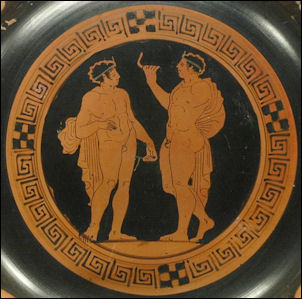 The Golden Age of Greece was during the rule of Pericles over Athens from 457 B.C. to 430 B.C. During this time the Parthenon was built, Aeschylus, Aristophanes and Sophocles were producing plays in the theater beside the Acropolis and democracy flourished. Pericles ruled over what has been described as the world's first democracy and mathematics, the arts, history, astronomy and philosophy flourished under Socrates, the Sophists, Herodotus and Thucydides.
The Golden Age of Greece was during the rule of Pericles over Athens from 457 B.C. to 430 B.C. During this time the Parthenon was built, Aeschylus, Aristophanes and Sophocles were producing plays in the theater beside the Acropolis and democracy flourished. Pericles ruled over what has been described as the world's first democracy and mathematics, the arts, history, astronomy and philosophy flourished under Socrates, the Sophists, Herodotus and Thucydides.
Under Athens and the Delian League the Greeks ruled much of the Mediterranean and trade flourished. Using iron to make tools, superior ships, weapons and machines Athens grew rich by exporting silver and olives. The money earned from this trade was used to construct other great building and support the arts and sciences.
But thing are not always as rosy as the seemed on the surface. A lot of the money used to build the Parthenon was looted from the Delios League treasury, less than a quarter of the population had political rights, slaves were often used instead of machines because they were cheaper, and war with Sparta was imminent. The upper classes ruled the government and many of the democratic reforms, such as payment for jury duty, were attempts to placate the lower classes with welfare payments and keep them in place. In the plains of Attica there only about 250,000 people. The population of the city-state of Athens had would later be reduced by the Peloponnesian wars and the plague from around 80,000 to as a low as 21,000."
Book: Athens, A Portrait of a City in Its Golden Age by Christian Meier (Metropolitan Books, Henry Holy & Company, 1998]
Ancient Greek Democracy
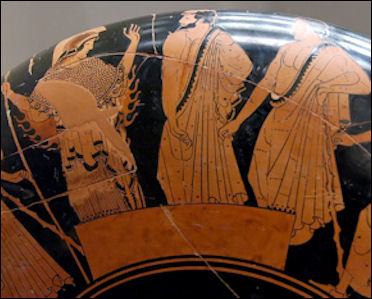
Voting sceneThe ancient Greeks are credited with founding democracy (a word derived from Greek words for people, demos , and kratos , rule) and literally means “rule by the people." In the early days most city-states, however, were ruled by local tyrants or oligarchies that formed citizen councils. The philosopher Democritus had nothing really to do with democracy. He is known for his theory on atoms.
Pericles wrote: "Our constitution is called a democracy because power is in the hands of the people, not a minority. When it is a question of settling private disputes, everybody is equal before the law; when it is a question of putting one person before another in positions of public responsibility, what counts is not membership of a particular class, but the actual ability which the man possesses. No one, so long as he has it in him to be of service to the state, is kept in political obscurity because of poverty...This is a peculiarity of ours: we do not say that a man who takes no interest in politics is a man who minds his own business; we say that he has not business here at all.
Plato once wrote democracy is a "delightful form of government, anarchic and motley." Some scholars have argued that democracy took root because citizens were more interested in success than domination. They were interested in impressing an audience or cutting a stylish figure than real power. There were few political institutions and the powers of persuasion held sway. Men had prove themselves in front of other men rather than hiding behind a birthrate or a title.
History of Democracy in Ancient Greece
Power was traditionally held by aristocracies, well-connected family, wealthy landlords, despots, military leaders and monarchs. A limited form of democracy first emerged in Babylon, which was ruled by an autocracy but had a popular assembly that made decisions on local affairs while presided over by a royal governor. Forms of democracy also existed in the Phoenician cities of Tyre and Sidon.
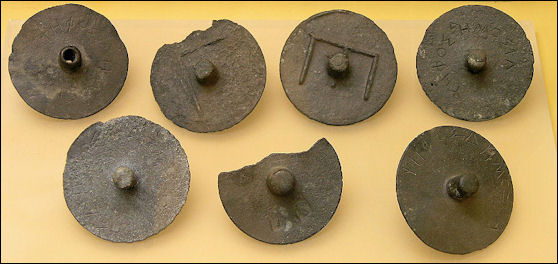
jetons used in voting
In Greece, the city-states were ruled first by local kings or chiefs and then by ruling families while local assemblies were created. At first the assemblies were only advisory bodies. Over time their power grew and they were able to put pressure on the city-state leader and ultimately even select them. Although the assemblies acted somewhat like democratic bodies their members were not democratically elected: they were mostly members of landowning families.
The earliest proto-democracy arose in a climate of war, social chaos and upheaval and was characterized by the people rising up to overthrow a cruel leader. The first so-called firm evidence of this kind of demokratia was documented in Athens in 507 B.C. after a cruel tyrant was assassinated by two gay lovers.
But evidence has been found that suggests that democracy was introduced decades earlier in the Italian colony of Metapontion, where the tyrant was killed by a young man named Antileon because the tyrant lusted after his male lover. Both men were caught and killed after they were slowed up in their escape by a flock of sheep tied together. After the death of the tyrant statues were erected to honor the lovers and shepherds were forbidden from tying their sheep together while driving them through the streets.
Democracy in Athens
In Athens the assembly had grown powerful enough by around 500 B.C. that it was making laws and electing magistrates. By the Golden Age period the powers of the ruler were limited and day to day affairs were run by a council made of 10 generals. There were no political parties.
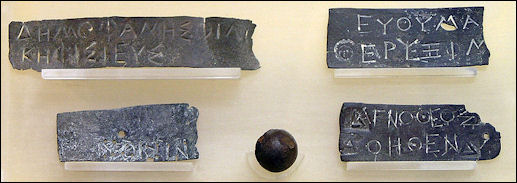
Ballots and tokens
Athens during it Golden Age was the home of the world's first democracy and the only polis with a government resembling a true democracy. Although the Athenian government had courts with juries and a political system where rich and poor free men were allowed to vote; women, foreigners, slaves and ex-slaves were not allowed to vote.
Athenian democracy was wild and chaotic and easily hijacked by demagogues. The Swiss historian Jacob Burckhardt described it as a “permanent terrorism exercised by the combination of sycophant, the or orators and the constant threat of public prosecution, especially for peculation and incompetence." Some historians say that the role of democracy has been exaggerated, and that Athens’ power resulted more from it military victories and money earned from trade than by a government supported by citizens.
Pericles
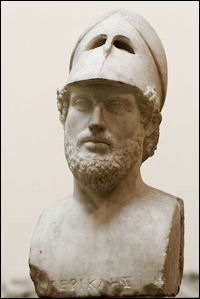
PericlesPericles (493-429 B.C.) ruled over what has been described as the world's first democracy. Although he never claimed the highest title, archon , and described himself simply as one of the ten generals elected each year by the citizenry he was firmly in control during his 27 year rule over Athens and owed his position to his will, charisma and oratory skills. He was the model for the tyrant Creon who condemns Antigone to death and for Oedipus the King.
Pericles instituted for public service, which expanded the realm of democracy, and looked after the welfare of the Athenian poor. But he also made Athens broke by diverted much of the money from the Delian League to finance the construction of Parthenon and other monumental structures.
Pericles was a nobleman with “the bluest blood” and came from one of the wealthiest Athens families. Despite this he was popular with ordinary Athenians and had the rhetorical skills to talk them in doing almost anything. He reportedly had big ears. Images of him show his big ears under a helmet. Pericles was Athens most brilliant statesmen and orator and he seemed know it. He said, "The admiration of the present and succeeding ages will be ours."
Image Sources: Wikimedia Commons, The Louvre, The British Museum
Text Sources: New York Times, Washington Post, Los Angeles Times, Times of London, Yomiuri Shimbun, The Guardian, National Geographic, The New Yorker, Time, Newsweek, Reuters, AP, Lonely Planet Guides, Compton's Encyclopedia and various books and other publications. Most of the information about Greco-Roman science, geography, medicine, time, sculpture and drama was taken from "The Discoverers" [∞] and "The Creators" [μ]" by Daniel Boorstin. Most of the information about Greek everyday life was taken from a book entitled "Greek and Roman Life" by Ian Jenkins from the British Museum [||].
No comments:
Post a Comment